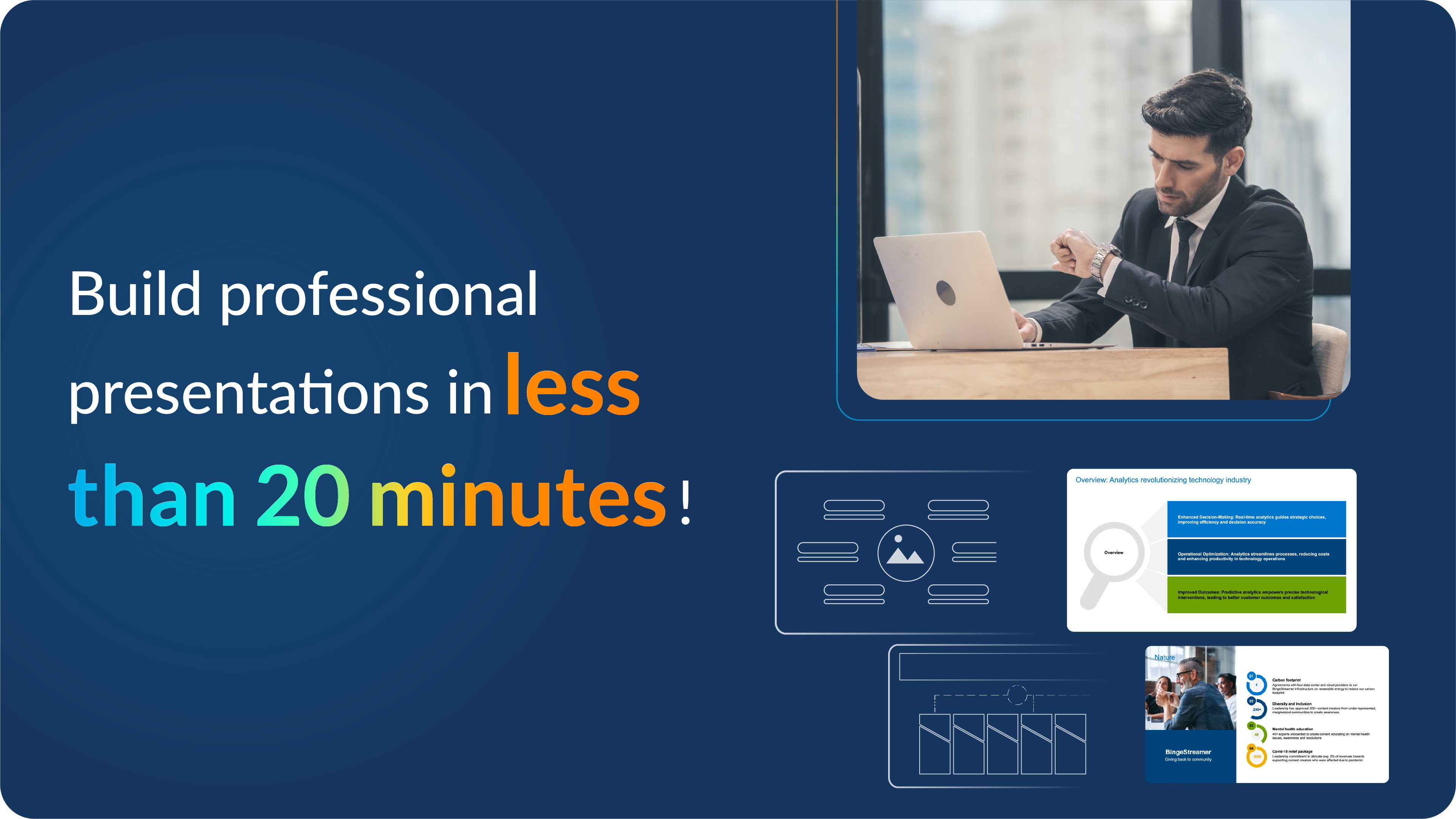Knowledge transfer presentation: A comprehensive guide

Hey there!
Welcome to the world of knowledge transfer presentations, where the exchange of expertise is not just an art but a strategic necessity.
In today's fast-paced business landscape, the ability to effectively transfer knowledge from one individual or team to another can mean the difference between stagnation and innovation.
In this comprehensive guide, we'll dive deep into the dynamics of knowledge transfer presentations, exploring what they are, how to structure them, and the do's and don'ts that will set you on the path to success.
But first, let's clear up the fundamental question:
What is knowledge transfer?
Knowledge transfer, as the term suggests, is the process of conveying information, expertise, and insights from one source to another. This can occur within an organization when a seasoned employee imparts their know-how to a newcomer, or it can involve the transfer of knowledge between different teams, departments, or even external partners.
Knowledge Transfer plays a pivotal role in ensuring that valuable insights and experiences are not lost but instead shared and utilized across various domains. Whether you're in the realms of technology, marketing, manufacturing, or engineering, the principles of knowledge transfer are universal.
How to present a knowledge transfer presentation
The Power of Presentation: Leveraging Knowledge Transfer in Slides
When it comes to transferring knowledge effectively, the use of slides and PowerPoint (PPT) presentations is a game-changer. These visual aids not only engage your audience but also provide a structured framework for sharing information. Let's delve into how you can make the most of this medium:
- Start with a knowledge transfer plan: Begin by crafting a knowledge transfer plan. This plan serves as your roadmap, outlining the key points, objectives, and the overall structure of your presentation. A well-thought-out plan ensures that your content remains focused and coherent.
- Embrace templates for success: Don't reinvent the wheel. Utilize a knowledge transfer template. These templates offer pre-designed layouts that are not only visually appealing but also help convey your message effectively. They save time and ensure consistency across your presentations.
- Master the art of presentation: A successful knowledge transfer presentation is not just about the content; it's about how you present it. Explore various presentation themes and layouts to find the one that best suits your message. Remember, a captivating design can enhance the audience's understanding and retention of the information.
- Engage your audience: Interactive elements like infographics and demonstrations can breathe life into your presentation. They break the monotony and ensure that your audience remains engaged throughout the knowledge transfer process.
How to structure a knowledge transfer presentation
Structuring a knowledge transfer presentation is crucial to effectively convey information from one person or team to another. Whether you are passing on expertise, skills, or institutional knowledge, a well-structured presentation can make the transfer process smoother. Here's a step by step guide on how to document a knowledge transfer presentation:
Define the purpose and objectives:
Start by clearly defining the purpose of your presentation. What knowledge or skills are you transferring, and why is it important? Define the objectives you want to achieve with the presentation.
Identify the audience:
Know your audience. Understand their level of expertise and their specific needs. Tailor your presentation to meet their requirements and expectations.
Create an outline:
Organize your content into a structured outline. Common structures include:
a. Introduction:
- Start with a brief overview of the knowledge transfer's purpose and importance.
- Introduce yourself and your background, establishing your credibility.
b. Main content:
- Divide the main content into logical sections or topics.
- For each section, provide clear explanations, examples, and relevant information.
- Use visuals, diagrams, and charts to enhance understanding.
- Share real-life anecdotes or case studies if applicable.
c. Hands-on demonstrations or workshops (if necessary):
- If the knowledge transfer involves practical skills, schedule time for hands-on activities, demonstrations, or workshops.
- Ensure participants have the necessary resources and materials.
d. Q&A and discussion:
- Allocate time for questions and discussions at appropriate intervals.
- Encourage participants to ask questions and share their insights.
e. Summary and recap:
- Summarize the key points covered during the presentation.
- Reiterate the main takeaways and objectives.
f. Conclusion:
- Close the presentation by emphasizing the importance of the knowledge transfer.
- Thank your audience for their participation and attention.
Use visual aids:
Incorporate visuals, such as slides, diagrams, and charts, to enhance understanding and retention. Keep visuals simple and relevant to the content.
Engage the audience:
Actively involve your audience throughout the presentation. Use questions, polls, and interactive activities to keep them engaged and encourage participation.
Provide resources:
Share additional resources, references, or materials that participants can refer to after the presentation. This could include documentation, manuals, links, or recommended readings.
Practice and rehearse:
Practice your presentation multiple times to ensure clarity, smooth transitions, and adherence to the allotted time.
Gather feedback:
After the presentation, solicit feedback from the audience. This can help you refine your knowledge transfer approach for future sessions.
Follow-up and support:
Offer ongoing support and assistance to the participants as they apply the knowledge or skills they've acquired. Make yourself available for questions or clarification.
Evaluate and adjust:
Assess the effectiveness of the knowledge transfer presentation by measuring whether the objectives were met. Use feedback to make improvements for future presentations.
Remember that effective knowledge transfer is not just about conveying information but also about ensuring understanding and application. Tailor your presentation to the needs and learning styles of your audience to maximize the impact of your knowledge transfer efforts.
Do's and don'ts on a knowledge transfer presentation
Now that we've covered the essentials of structuring a knowledge transfer presentation let's navigate through the do's and don'ts that can make or break your presentation:
Do's:
- Involve your team: Knowledge transfer is a collective effort. Encourage your entire team to participate and share their expertise.
- Be clear and concise: Keep your content editable and easy to understand. Avoid jargon and complex language that may confuse your audience.
- Leverage technology: Embrace technology solutions that facilitate knowledge sharing and make the process efficient.
- Empower your employees: Foster a culture of knowledge sharing within your organization. Make sure that your employees understand the value of sharing their tacit knowledge.
Don'ts:
- Overload with information: Avoid overwhelming your audience with excessive data. Stick to the most relevant and valuable information.
- Neglect communication: Effective communication is key to knowledge transfer. Ensure that there is a clear channel for questions and feedback.
- Ignore strategy: A well-defined knowledge transfer strategy is essential. Don't proceed without a plan in place.
- Lose sight of the outcome: Always keep the desired outcome in mind. What do you want your audience to take away from the presentation?
Summarizing key takeaways
- Knowledge transfer is the process of sharing information and expertise, crucial for innovation in today's fast-paced business environment.
- Using slides and powerpoint presentations enhances knowledge transfer by engaging the audience and providing structure.
- Starting with a well-defined plan and utilizing templates ensures focused and coherent content in your presentation.
- Design and layout are essential; explore various themes to enhance audience understanding and retention.
- Structuring a knowledge transfer presentation involves defining objectives, understanding the audience, creating an outline, using visuals, engaging the audience, and providing resources.
- Practice and rehearsal are essential for clarity and smooth transitions during the presentation.
- Continuous evaluation and adjustment based on feedback are vital to improving the effectiveness of knowledge transfer efforts.
FAQ's
1. What is knowledge transfer, and why is it essential for organizations?
Knowledge transfer is the process of sharing and disseminating knowledge within an organization to improve its performance. It involves the knowledge management of explicit and organizational knowledge. Effective knowledge transfer can enhance workplace productivity and innovation.
2. How can I effectively manage knowledge transfer in my organization?
Managing knowledge transfer requires a structured approach. You can start by identifying the stages of knowledge transfer and creating a management plan. This may involve selecting the right software or database to store and share information, and implementing best practices for knowledge sharing.
3. Are there customizable templates available for knowledge transfer presentations?
Yes, there are customizable templates, including powerpoint and google slides, designed specifically for knowledge transfer presentations. These templates provide a professionally designed framework to help you prepare and present your knowledge effectively.
4. What are the key components of a successful knowledge transfer presentation?
A successful knowledge transfer presentation typically includes clear and concise ppt slides, pdf, an action plan, and an infographic to aid understanding. It should also address the identification of knowledge holders, the creation of trust among team members, and an analysis of the current knowledge landscape.
5. How can knowledge transfer benefit new employees and project transitions?
Knowledge transfer is invaluable for onboarding new employees and ensuring smooth project transitions. It allows new team members to download crucial information, learn from mentors, and quickly become productive contributors. Additionally, it helps prevent knowledge silos and ensures that critical knowledge isn't lost when employees leave the organization.
Create your knowledge transfer presentation with prezent
Knowledge transfer is the lifeblood of any successful organization, and Prezent is here to make that process smoother than ever. With our enterprise AI presentation tools, you can craft compelling knowledge transfer presentations that ensure information flows seamlessly within your team.
Firstly, our "Personalized fingerprints" feature allows you to tailor your knowledge transfer presentations to the preferences of your audience. This means that your information not only gets conveyed effectively but also resonates with the individuals you're sharing it with, enhancing retention and understanding.
Secondly, our "Presentation builder" is designed for simplicity and impact. It empowers you to create visually engaging knowledge transfer presentations effortlessly, even if you're not a design expert. This means your team can access critical information in a format that's easy to digest.
Lastly, our "Real-time sharing + collaboration" feature fosters teamwork. Whether your colleagues are within or outside your organization, they can collaborate with you in real-time to refine your knowledge transfer presentations. This collaborative approach ensures that the information being shared is comprehensive, up-to-date, and aligned with your organizational goals.
In summary, Prezent is the ideal tool to streamline knowledge transfer within your organization. It enables personalized, visually engaging presentations that are easy to collaborate on, ensuring your team has access to the information they need to excel.
Sign up for our free trial or book a demo. So why wait? Start transferring knowledge effectively today!


.avif)









